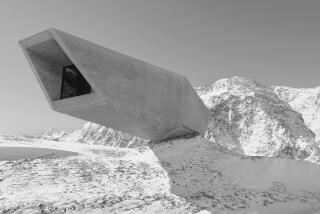Blueprint of an Architect
- Share via
“If I had another 15 years to work,” Frank Lloyd Wright tells us at the beginning of Ken Burns and Lynn Novick’s documentary, “Frank Lloyd Wright,” “I could rebuild this entire country.” He came remarkably close.
Up until his death on April 9, 1959, at 91, Wright designed nearly 800 buildings--a phenomenal number given the high level of the work. Many were outright masterpieces. Together, they form a brilliant vision of remarkable scope, from humble single family houses to entire new urban forms. In the process, Wright repeatedly reinvented both his architectural vision and his own mythical persona.
So how to encompass a life of such breadth in 157 minutes? Burns and Novick’s documentary, tonight and Wednesday on KCET-TV, seeks to find the link between the turbulence of Wright’s personal life and the genius within, to lay bare the creative imagination. It is compelling because Wright was both a monstrous character and the greatest artist this country has ever produced, and therefore, his life is too broad to neatly package. Like it or not, it constantly spills over into the margins.
The biographical details are by now well known. Born in Wisconsin shortly after the Civil War to a mother who assumed his impending greatness, Wright began his career in Chicago, as an apprentice to Louis Sullivan, then the country’s most revered architect. He quickly emerged as an unconventional figure amid the petit bourgeois conventions of Oak Park, the wealthy Chicago suburb where the young Wright lived with his wife, Kitty, designing a series of Prairie-style houses that established his genius.
Yet that genius constantly seemed on the verge of self-destruction. He fought with Sullivan, ultimately breaking with the older architect because Wright had claimed responsibility for some of Sullivan’s designs. Soon after, Wright ran off with Mamah Cheney, the wife of a close friend and client, leaving Kitty with mounting debts and six children. Five years later, the affair ended with the greatest tragedy of Wright’s life: the murder of Mamah and six others at Taliesin, his Wisconsin workshop, by a deranged servant. That tragedy was followed by the collapse of Wright’s career, a decade during which he was discarded as a middle-aged burnout, and then his glorious resurrection with the completion of two of the 20th century’s greatest masterpieces: Fallingwater (1936) in Pennsylvania and the Johnson Wax Administration Building (1939) in Wisconsin. From that point, he survives to become the legend we now know.
Questioning the Nature of Artistic Creation
In telling this story, Burns and Novick stumble across many of the obvious cliches. The arrogant artist. The resurrected hero. Yet the two-part PBS film also manages to raise complex questions about the nature of creative invention. Wright was clearly a genius. But what made him a greater genius than all the others? The person who comes closest to answering that is Philip Johnson, the 93-year-old architect and curator who more than 60 years ago famously dismissed Wright as America’s greatest 19th century architect. Yet Johnson, here, is genuinely awe-struck by Wright’s ability to keep inventing, to continually turn new corners just when others wrote him off.
Johnson calls the central work space of the Johnson Wax building the finest room in the United States. “That is architecture to me and most architects. To create a space where you feel the awe of religion without the mumbo jumbo,” he says. The man who commissioned the building, Herbert Johnson (no relation to Philip), remarks of the difficulties of working with Wright, “At first, Frank Lloyd Wright was working for me. . . . Then we were working together. Finally, I was working for him.”
Such conflicting insights are woven throughout here, and they shed some light on the uniqueness of Wright’s accomplishment. Those who are unfamiliar with architecture will, one hopes, come away with a sense of the difficulty of creative struggle. And they will get a glimpse into what makes Wright’s architecture truly great: his divine ability to fuse form, structure, nature and social forces into objects of compositional beauty--to push the limits of what is possible.
Perhaps the most moving voices, however, are those of the people Wright left behind--his son, grandsons and disciples--who both revere the man and retain the scars of his reckless willingness to experiment. They remind us of the complexity of life, that one can be generous in one’s work and destructive in one’s life. Wright was forgiven for being an egotist, of course, because he was a great artist. Yet the damage he did to those around him seems chilling here at times. His mission, of course, took precedence. Whether one can or should excuse this is left unanswered.
Architecture, however, ultimately lives outside the self. Its generosity lies in its existence beyond one man’s life. If the legacy of Wright’s personal turmoil has faded, his work continues to shape the future of architecture. He was one of the great geniuses of any era. And as such, his work soars high above the banalities of our common lot.
* “Frank Lloyd Wright” is shown tonight and Wednesday at 9 on KCET-TV.
More to Read
The complete guide to home viewing
Get Screen Gab for everything about the TV shows and streaming movies everyone’s talking about.
You may occasionally receive promotional content from the Los Angeles Times.






